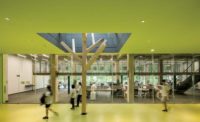Seoul, South Korea
When architects—or politicians, for that matter—speak of walls, they usually see them as boundaries dividing one place from another. UnSangDong Architects took a radically different approach at a new house outside of Seoul, punching openings through them, making them portals and creating unique opportunities to bring in light and frame views. Instead of barriers, they’re thresholds.
UnSangDong, a RECORD Design Vanguard winner in 2006, has established a reputation for inventive designs that use folded, layered, and faceted forms to create striking identities for buildings. With Wall House, the firm defines the project’s structure and image with a set of five parallel brick walls, each 35 feet high. Spaced at different intervals from one another, the imposing brick planes create a visual rhythm that modulates interior and exterior spaces—from generous living and dining rooms to narrower service areas.
Designed by someone less skilled, such a scheme could have been overbearing or rigid. But UnSangDong partner Mijung Kim cut away much of the brick fabric, to give the house an open and spacious feel—with views through rooms and up to the second floor in certain places. By extending the walls horizontally beyond the enclosed portions of the house, Kim created outdoor rooms on the ground level and terraces or balconies for the bedrooms on the second floor. And by extending the walls vertically above the roof, she was able to define a garden that is open to the sky but shielded from sight of neighboring houses. A grassy courtyard on the ground level brings daylight deep inside and further blurs the distinction between inside and out. “We wanted nature to penetrate inside,” says Kim. “The idea was to make people feel as if they’re outdoors when they are inside, and inside when they are out.”
The 2,500-square-foot house sits in Pangyo, a low-rise residential community, and serves three generations of a Korean family—a married couple, their two children, and a grandmother. An acquaintance of the grandmother recommended UnSangDong, and it was she who asked for a brick house, but a modern one. Encouraging communication between family members was important to the clients, so Kim and her team created horizontal axes that, along with double-height areas, visually connect one floor to another. For example, the grandmother likes to watch the kids doing their homework in the second-floor study as she relaxes in the living room on the first floor. “Creating the right balance between privacy and communication was important,” says Kim.
The architect sees the openings in the parallel walls as frames for sequences of spaces, creating an almost cinematic experience. Using the term “chrono-topic,” Kim says she tried to “integrate time and space through a combination of varying surfaces and intersecting axes.”
The husband, who works for Samsung, made sure the house was equipped with the latest technology, so everything from heating and air-conditioning to lighting and security is networked and automated. Solar panels on the roof provide most of the energy needed to power the house.
Although Wall House is modern in the way it functions and looks, its integration of indoors and out is a hallmark of traditional Korean houses, or han-ok, says Kim. Such a blurring of periods is another way Kim has integrated “time and space.”











Post a comment to this article
Report Abusive Comment